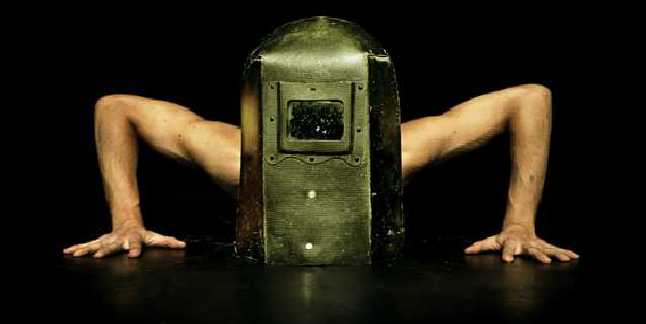Work, work, work. Never stopping, fighting to meet the productivity deadlines… That’s all there is – that and a fitful night’s sleep, dreaming terrible dreams, until it is time to get up and get back on the treadmill. That is the sum of a working man’s life.
Surrounded on three sides by audience, a lone male performer jogs and climbs and runs, his skin dripping with sweat, finally collapsing breathless, forcing himself to his feet despite exhaustion, battling on. Lying prone on the floor, his heels hammer the floor as his voice chants in time to the tattoo: ‘lavora, sogna, lavora, sogna’. Work, dream, work, dream. This isn’t mere acting – this body is being pushed; being worked and worked and worked.
Subtitled, for reasons I don’t fully understand, ‘the contemporary hermit’, Made In ILVA explores ‘the impact of the biggest steelworks of Europe, on the environment and surrounding population’. At least, that is what it claims to do – the reality is a riveting solo performance that seems to be less specific and more universal – a reflection on the oppression of capitalism, and the subjugation of the working-class male body to the harsh injustices of manual labour.
It’s a beautifully staged and performed piece, directed with precision by Anna Dora Dorno, informed in its making by Meyerhold’s biomechanics (a system of intense physical performance practice that seems to have dropped off the radar somewhat in recent times). A modest-sized steel structure morphs from chair to ladder to cage – rocked, tipped, swung from, climbed on and under. A square on the floor acts as a canvas for painting in light: sepia and blackberry coloured projections of industrial buildings; or at other times harsh unforgiving blocks of intense colour, scarlet or canary yellow. A rubber mat running from the square into the audience’s spaces is a runway for tortuous and tortured journeys – walking, crawling, running.
The lone man on stage, Nicola Pianzola, gives an earth-shaking performance. There is no physical let-up, and as he moves, he speaks – a poetic, percussive text that echoes the pre-recorded soundtrack. I witness the piece without knowing anything of its provenance. I’m interested to learn afterwards that verbatim texts by steelworkers from the fated plant (which has seen 180 deaths and thousands of injuries over the decades). Little of this is evident in what we see and hear – although a wonderful last ten minutes of soundscape mixing a multitude of voices leads me to wonder if perhaps Ricardo Nanni’s sound composition (which is overdubbed in English) has lost some of its content and power in the rejigging for an English-speaking audience.
That aside, and focusing on what was presented rather than what is claimed in programme notes, this is a rare and wondrous piece of physical performance, a privilege to experience.

